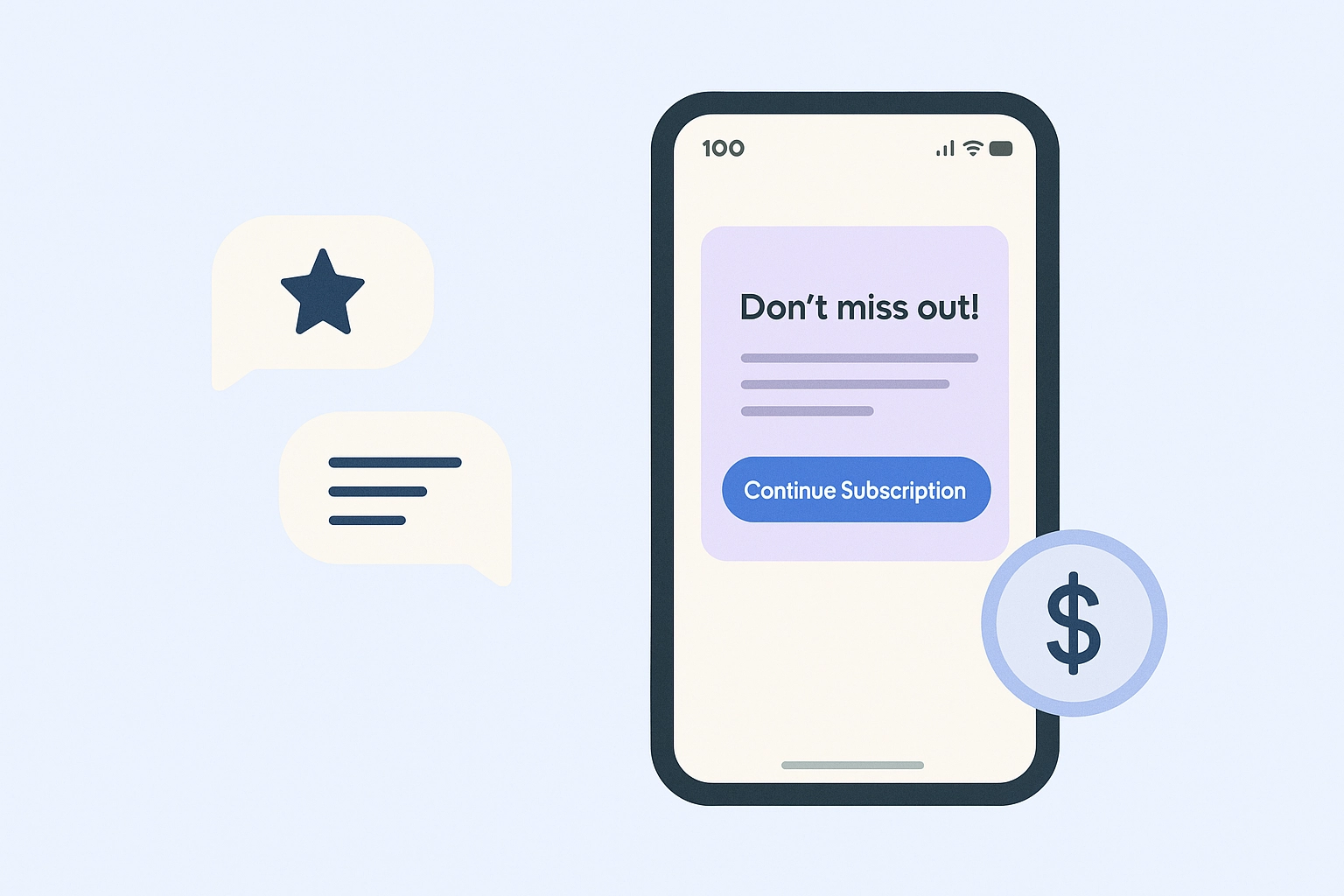Win Back App Subscribers: How to Use Apple’s Retention Messaging API to Reduce Churn
Published 23rd July, 2025 by Stuart Hall Churn is a tough pill to swallow. Whether you’re launching your first subscription app or managing a whole suite of them, it’s disheartening to watch users cancel. Fortunately, Apple’s new Retention Messaging API puts a powerful new tool in your hands, one designed to intervene at the precise moment a user decides to leave. And the best part? The data shows it works. In this post, we’ll show you how to leverage this feature to reduce churn and keep more subscribers on board.
Churn is a tough pill to swallow. Whether you’re launching your first subscription app or managing a whole suite of them, it’s disheartening to watch users cancel. Fortunately, Apple’s new Retention Messaging API puts a powerful new tool in your hands, one designed to intervene at the precise moment a user decides to leave. And the best part? The data shows it works. In this post, we’ll show you how to leverage this feature to reduce churn and keep more subscribers on board. What we cover:
- What is Apple’s Retention Messaging API?
- The Research: Retention Messages & Discounts Work
- The Role of Discounts
- How to Implement Retention Messaging with Apple
- Get Ahead of Churn: Use Ratings & Review Feedback
- Best Practices for Effective Retention Messaging
- Final Thoughts
Want to monitor & track your app reviews?
Try Appbot free now, no credit card needed →What is Apple’s Retention Messaging API?
Apple now allows developers to send custom retention messages, like reminders, benefits, or even discount offers, when a user visits the subscription cancellation page in the App Store, through Apple’s Retention Messaging API.
When a user taps “Cancel Subscription,” Apple pings your backend and asks: “Got anything to say before they go?” Your server responds with a pre-approved message (created in App Store Connect), which Apple then displays right in the UI.
The Research: Retention Messages & Discounts Work
Real-world data backs up the power of strategic messaging at cancellation:
- Offering a discount or alternative at the moment of cancellation can reduce churn on average of 32%, with some apps reporting gains up to 45%, depending on the timing and segmentations (RevenueCat).
- Nearly 40% of users cancel due to price, and well-timed offers help win many of them back (Loop Work).
- LogRocket found that framing a discount as something users would lose if they left reduced churn by 18%, a tactic based on the “endowment effect” (LogRocket).
- Apps that use in-flow messaging during cancellation saw retention rates 2.4× higher than those offering no message or only static screens (RevenueCat).
Types of Retention Messages Supported by Apple
Apple currently supports four message formats when using the Retention Messaging API:
- Text-based message: A simple message containing only text to remind users of value or ask them to reconsider.
- Text-based message with an image: A message that includes both text and an image, ideal for reinforcing brand, emotion, or product features.
- Switch-plan message: Contains text and a suggested subscription plan the user may switch to, offering a more relevant or affordable alternative.
- Promotional-offer message: A message that includes text and a promotional offer to continue at a discounted rate, either on the same plan or a different tier.
What Kinds of Retention Messages Work Best?
The effectiveness of Apple’s Retention Messaging API hinges on what you say in that crucial moment when a user is considering cancellation. Based on industry research and real-world results, here are the most impactful types of retention messages you can use:
| Type of Message | What It Does | When to Use It |
|---|---|---|
| Discount Offer | Presents a time-limited savings opportunity | When price is a known churn driver |
| Feature Reminder | Highlights a valuable feature the user may not be using | When usage has declined or feels low |
| Plan Downgrade | Suggests a lower-tier plan instead of canceling entirely | When users feel the app is too expensive |
| Milestone Highlight | Celebrates user progress or achievements in the app | To remind them of long-term value |
| Customer Support Prompt | Offers help or directs them to support before canceling | When reviews mention bugs or confusion |
| Loss Framing Message | Reminds users what they’ll lose if they cancel (e.g. saved data, discounts) | To tap into endowment/loss aversion bias |
Each of these message types aligns with a specific user mindset. The more you personalize and time your messages based on behavior and sentiment, the more likely you are to keep them around.
The Role of Discounts
While discounts are a proven win-back strategy, overusing them can erode long-term brand value and train users to wait for a deal. Instead, balance them with other sustainable tactics:
- Personalized messages that highlight value based on usage.
- Loyalty rewards that build engagement over time.
- Feature reminders that reconnect users with what they loved.
Discounts work best when they’re targeted, timely, and rare, not expected.
How to Implement Retention Messaging with Apple
- Define & upload your messages in App Store Connect and submit them for Apple’s approval. Only messages marked “APPROVED” will be eligible.
- Build your “Get Retention Message” endpoint:
- Make it a TLS 1.2‑secured HTTPS POST endpoint.
- Must respond within 700 ms or Apple will drop the request.
- Endpoint receives a RealtimeRequestBody and must reply with a RealtimeResponseBody, specifying which approved message to display.
- Share your URL with Apple, using the “Request access to the Retention Messaging API” form. Once validated, the App Store will call your endpoint whenever a subscription detail page loads.
Key technical requirements at a glance
| Requirement | Details |
|---|---|
| SSL & TLS support | Valid cert & TLS 1.2 required |
| Endpoint performance | Must reliably respond in ≤ 700 ms |
| Response format | Proper JSON conforming to RealtimeResponseBody schema |
If your endpoint fails or times out, Apple falls back to its default retention message or none, if no default exists.
Get Ahead of Churn: Use Ratings & Review Feedback
Retention shouldn't start on the cancellation page. Often, users are giving clear early warning signals, you just have to be listening. Many of the problems that lead to cancellations are already showing up in your app reviews:
- Bugs or crashes in recent updates
- Poor onboarding or confusing UI
- Missing features or pricing frustrations
- Bad support experiences
By using a tool like Appbot to analyze review sentiment, keywords, and trends, you can spot patterns early and fix issues before users start canceling. For example: If a drop in ratings or a spike in refund mentions coincides with a feature rollout, you might uncover an issue weeks before it turns into churn. Users cancel because something didn’t feel worth it. Fix that, and your messaging becomes a bonus, not a lifeline.
Best Practices for Effective Retention Messaging
Retention messaging only works if your app delivers real value. These best practices help ensure your messages reinforce, not replace, a great user experience:
- Localize messaging: Adapt language, tone, and offers to feel relevant in each market you serve.
- Ensure accessibility: Use legible fonts, plain language, and support tools like VoiceOver so every user can engage with your message.
- Stay compliant: Follow Apple’s guidelines and local regulations for promotional messaging, especially around pricing or limited-time offers.
- Track and iterate: Track which messages were displayed and correlate them with renewal actions to improve your messaging over time.
When your product is reliable, inclusive, and responsive to user needs, retention messaging becomes a trusted nudge.
Final Thoughts
Apple’s Retention Messaging API is more than just a new endpoint, it’s a critical opportunity to change the conversation at the exact moment when users are deciding whether to stay or go. And the data is clear:
- Discounts work, but need thoughtful, balanced use.
- Personalized, well-timed messages reduce churn significantly.
- Proactive listening through reviews helps avoid churn in the first place.
If you’re already using Appbot to monitor sentiment and feedback, this is your chance to take the next step: predict churn before it happens and respond in real time when it does.
Want to monitor & track your app reviews?
Try Appbot free now, no credit card needed →Where to from here?
- Explore the strategies employed by top grossing apps and learn how to achieve success.
- Master the art of writing an irresistible app store description that captures attention and drives downloads.
- Reply to app store reviews on the Apple and Google Play stores for happier customers and better star ratings.
- Dive into the secrets of creating addictive apps that keep users hooked and coming back for more.
About The Author

Stuart is Co-founder & Co-CEO of Appbot. Stuart has been involved in mobile as a developer, blogger and entrepreneur since the early days of the App Store. He built the 7 Minute Workout app in one night and blogged the story of growing the app to 2.3 million downloads before exiting to a large fitness device company. Previously he was the co-founder of the Discovr series of applications which achieved over 4 million downloads. You can connect with him on LinkedIn.
Enjoying the read? You may also like these
 WWDC 2025: Apple's thoughtful approach to everyday AI across devices
WWDC 2025: Apple's thoughtful approach to everyday AI across devices Apple's WWDC 2025 showcased a thoughtful rollout of AI features designed to enhance everyday tasks across iPhone, iPad, Mac, and Apple Watch, without compromising privacy
A guide for aspiring indie iOS developers highlighting all the essential Apple developer resources from Swift and Xcode to SwiftUI tutorials and tools to help you build and launch your first iOS app
Want to learn WHEN to prompt an app review? See our advice after talking to thousands of mobile app developers on best techniques for IOS and Android apps.
Write an effective app description in 2024. We analyzed 2100 top charting apps to provide you with app description examples, and a practical app description template.


